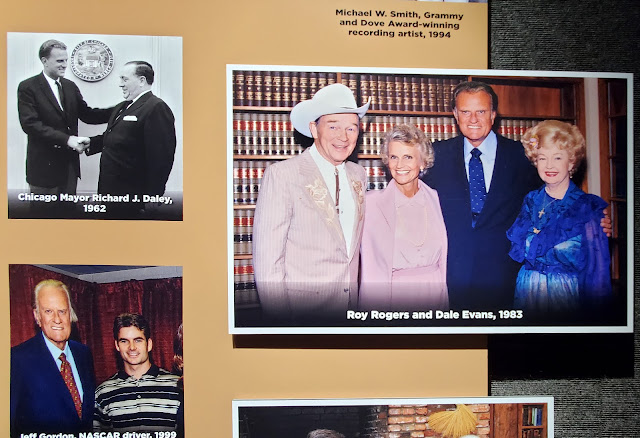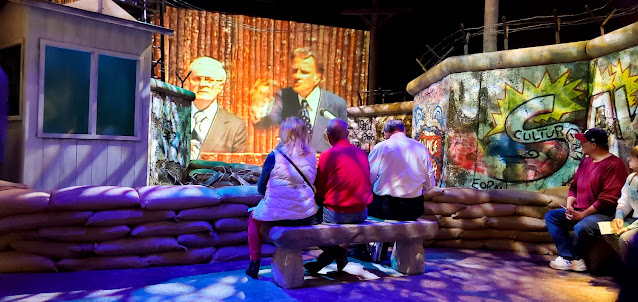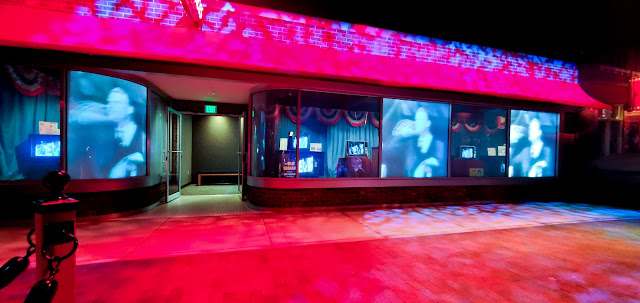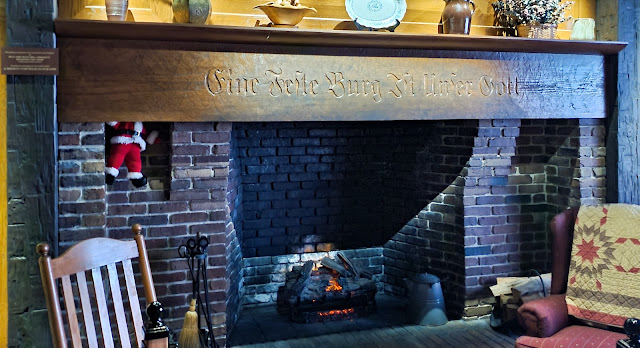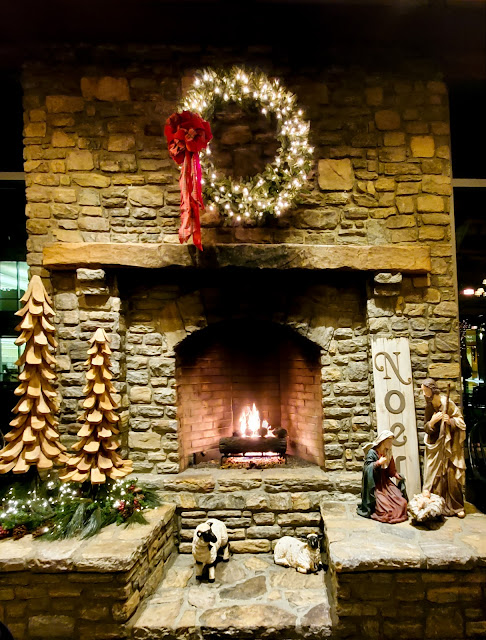CANADIAN MARITIMES TOUR. This was not an RV tour. We traveled with Tauck Tours. Today we flew into Halifax, Nova Scotia from Quebec City. The Maritimes tour did not start until the next day, so we relaxed at the Prince George Hotel and walked around Halifax a bit. Halifax was not nearly as picturesque as the cities in the prior tour. It is much more modern-looking.
CLICK ON ANY PHOTO TO ENLARGE
 |
| View from Our Room at the Prince George Hotel |
All the time on our prior tour in the Capital Cities, the tour guide marveled at how bright and clear the weather was, noting that on all prior tours it rained on the walking tours. Once we got to the Maritimes, the weather was cloudy with bouts of rain. Worst of all, Hurricane Lee had devolved into a tropical storm, but still causing much alarm due to memories of Hurricane Fiona's impact the same time last year. That storm did extensive damage, surprising everyone, since storms like that in that location were very rare. So, two years in a row, at that exact time of year, another serious storm was headed our way. We had dodged it on our prior tour only to deal with it now. But that would come later. At this point, the storm was off the coast of Georgia.The following day was the official start of the Maritimes tour, which began with a visit to the Halifax Citadel, a fort at the waterfront of the city.
 |
| Waterfront View Across from Citadel |
Before supper upstairs, there was a performance of a bagpiper and firing of muskets. The demonstration included showing us the difference in speed of loading and firing a breech loader compared to a muzzleloader. The man firing the former got off round after round rather quickly. The woman never did get her muzzleloader to fire. We were late to supper waiting for her to get one off. And, of course, the ever-present piper. |
| Musket Firing Demonstration |
 |
| Piper and Guide |
The following day we visited Peggy's Cove, famous for its scenery and its individual post office enabling one to mail a post-marked card from Peggy's Cove to friends or family. When we got there, however, it was dismally overcast. The Tauck tour guide tried to convince us that this is vintage Peggy Cove weather, which we knew was not true. Consider all the pictures for sale in the gift shop. All of those keepsakes are of sunny and clear days. |
| Peggy's Cove On Our Visit |
 |
| Gift Shop Pictures for Sale |
Next we stopped off at Mahone Bay to see the well-known views. |
| View Across Mahone Bay of Three Churches |
 |
| Zoom In On the Three Churches |
The three churches are St James Anglican Church on the left, St Johns Evangelical Lutheran Church in the middle, and Trinity United Church. The United Church denomination is the result of the merger in 1925 of the Methodist, Congregational, and 70% of the Presbyterian churches in Canada. It seems they decided that they could not determine any significant differences in their doctrine at this point in Canadian history, so they threw in together. The other 30% of Presbyterians continued as the Presbyterian Church of Canada. The United Church was so buried in trees that I could not get a good shot of it.
 |
| Simple Cottage with Large Five-sided Scottish Dormer |
 |
| Prosperous Merchant's Home |
It seems that most towns in Canada have a piece of the Berlin Wall. Below Betty stands beside such a piece located beside the Royal Canadian Legion building.
 |
| Betty Beside a Piece of the Berlin Wall |
 |
| Closeup of the Segment of the Berlin Wall |
Our walking tour included a view of the Lunenburg Academy, which was founded to school the children of Lunenburg. It is still in limited use for various kinds of learning experiences.
 |
| The Lunenburg Academy |
As we departed Lunenburg, we passed the harbor front where fishermen had constructed a colorful Christmas tree out of lobster traps.
 |
| Lunenburg Christmas Tree |
The next day began with a visit to the Halifax Fairview Lawn Cemetery, which devotes a section to victims of the sinking of the Titanic. Many bodies, some identified and some not, were brought here to be interred.
 |
| Fairview Lawn Cemetery Halifax |
 |
| Gravesites for Those Who Could Not Be Identified |
Among those who could be identified, a few images have been selected for viewing below.
 |
| Honorable Titanic Crew Member |
 |
| Touching Epithet |
 |
| The Title of the Hymn Played by the Orchestra as They Sank |
 |
| Another Reference to the Same Hymn |
Next we visited Pier 21, the immigration area for outsiders coming into Canada seeking citizenship. We were addressed by a recent immigrant from Iran whose family first fled to Indonesia as a safe haven until they could acquire citizenship in Canada. The remainder of her family is still waiting after 10 years in Indonesia to be accepted. She delivered a very emotional talk.
 |
| Recent Immigrant to Gain Citizenship |
There were many exhibits here, many of old black and white fuzzy photos of mobs of people seeking citizenship. This was one of Canada's "Ellis Islands." Below shows the primary locations from which people came to enter Canada, and primary locations where they were brought into Canada.
 |
| Chief Locations of Departure for Immigrants |
 |
| Chief Locations for Entry into Canada for Immigrants |
 |
| Here is the Pledge New Immigrants Must Make |
After Pier 21, we were free to explore the Halifax waterfront.
 |
| One View of the Halifax Waterfront |
 |
| Locals Step In for a Chilly Dip Here |
 |
| Where They Make the Fog |
From here we departed for the Millbrook Cultural and Heritage Centre just outside Truro, NS.
 |
| Millbrook Cultural and Heritage Centre |
Inside, along with the obligatory stuffed wildlife, we got a free cup of we-goon-ah-boo (coffee), followed by a congenial and helpful discussion with native Mi'kmaq villagers who live nearby.
 |
| Stuffed Wildlife Exhibits |
From here we left for Moncton, New Brunswick. There we stayed at the Delta Beausejour Hotel near the Petitcodiac River, which narrows as it flows from the Bay of Fundy, creating a tidal bore. A tidal bore results when the huge tidal changes in the Bay of Fundy cause the water in this otherwise placid river to roll back
upstream in a wave that ranges in height from three cm (one in.) to 75 cm (30
in.) and at speeds up to 13 km (8 mi.)/hour. The only time we could witness it was after dark at a time when we were scheduled to eat supper. Hence, we did not see it. But Betty got a nice shot of the placid river in good light before it got dark.
 |
| Scene Along the Petitcodiac River in Good Light |
The next day we left for Hopewell Rocks on Hopewell Cape, NB. Photos of this place grace travel brochures because of the unique rock formations derived from the huge tide shifts in the Bay of Fundy. In good weather (and good light) photos of this place are stunning. We did the best we could given the conditions we had. |
| About the Best I Could Do With Overcast Lighting |
 |
| As The Bay of Fundy Tide Went Out, So Did We |
 |
| Water Level Now Is Far Out Into Bay |
The following day we rode to Pointe-du-Chene, NB to depart on a Lobster Cruise in the Shediac Bay. This is another example of the deep French influence in this part of Canada. With a name like New Brunswick, you would expect a heavily English culture, but this is Acadian country.
Due to harsh memories from last year's damage caused by Hurricane Fiona, locals were pulling their boats out of the harbor's water to dry dock as we watched. A leery eye was being kept on Hurricane Lee that slowly approached the area.
 |
| Example of Boat Headed for Dry Dock |
 |
| Our Cruise Boat Awaits in the Harbor |
Our Acadian cruise host made ample use of this opportunity to school us on all things Acadian, including how they prepare lobster. They did a fine job except that their final step is to dunk the lobster into ice cold water to make it easier to get the meat out of the shell. Thus, we were served cold lobster. Bad idea. Maine has a better idea, cook, peal, and drop warm lobster meat into a boat of warm drawn butter. They call it Naked Lobster. Highly recommended. |
| Even Our Tables Were Acadian Flags |
Our exuberant Acadian ship captain and host put on quite a presentation, including having guests handle live lobsters.
 |
| Our Host Giving a Demonstration to Guest |
 |
| I Had Lobster. Betty Had Chicken. |
After the cruise, we headed for Prince Edward Island to stay at the Delta Prince Edward Hotel in Charlottetown. Before we crossed the bridge to PEI, our tour guide stopped to allow us to view the expanse of the bridge. Before this bridge was constructed, only ferries could cross here, which was more expensive and took longer. Ferries still do cross on the other side of the island, as we shall see later in our tour.
 |
| St Dunstan's Basilica |
 |
| Zion Presbyterian Church |
I also walked by a local shop named for Anne of Green Gables, the Green Gables Chocolates.
 |
| Green Gables Chocolates |
Another noteworthy site is the Province House National Historic Site. Out front is a war memorial for those from PEI who fought in the wars of the 20th century. This site is where the negotiation was completed for the confederation of Canada. This is where the various provinces agreed to form a single nation, Canada. Having seen how different this part of Canada is from western Canada, I am surprised that it ever happened. The complication of French-speakers sharing space with English-speakers is far greater than most people understand. It appears that the French language forms the thought patterns and outlook in a way that conflicts with everyone else. I have heard that there was a point in the 19th century when western Canada seriously considered joining America due to this very difference with eastern Canada.
 |
Province House National Historic Site
War Memorial In Front |
Victoria Row is a street in Charlottetown with many buildings of Victorian architecture. I did not have time to walk down it to see individual buildings, so I just took a couple photos. It is actually Richmond Street, between Queen and Great George Streets. It has become a popular shopping mall.
 |
| Entrance to Victorian Row |
 |
| View Down Victorian Row |
Later we departed for Brackley Beach on the central north shore of PEI. Along the way, we stopped along the waterfront, where a piper was waiting to serenade us.
 |
| Piper Poses With Us |
 |
| Betty the Piper Peeper |
 |
| Brackley Beach |
Betty wanted to get her feet wet but did not want to remove her shoes. So, she stepped into Brackley Bay with her shoes on! Go figure.
 |
| Betty Steps Into Brackley Bay |
After that we visited the Anne of Green Gables Museum on Campbell's Pond. Down the road from it is the gravesite of Lucy Maud Montgomery, the author of the book of the same name. The actual location of the filming for the movie was done in Toronto, shot in a house constructed to look like this one but large enough in the rooms to accommodate movie cameras and sound equipment.
 |
| Entry Road to Anne of Green Gables Museum |
We walked through the house, room by room, with some more photogenic than others. A few of the rooms are pictured below.
 |
| Pantry |
 |
| Kitchen |
 |
| Dining Room |
 |
| Bedroom |
 |
| Bedroom |
 |
| Bedroom |
 |
| Antique Newspaper Lying On a Chair in Bedroom |
 |
| Stairway Out Back Door Leading to Haunted Wood |
A sign along the Haunted Wood Trail explains that there is nothing haunted or otherwise unusual about this trail. The spookiness resided solely in the young imaginative minds of the girls in the story.
 |
| Sign on Haunted Wood Trail |
 |
| Not Too Scary-looking By Day |
 |
| Trees Like This In the Dark Might be Scary |
 |
| Then the Trail Runs Into a Golf Course! |
 |
| Eventually the Trail Splits in Two |
I walked the trail a long way until it split in two. Enough was enough!
Due to the approaching storm, now getting close enough that two days after visiting Peggy's Cove it had flooded, our tour guide altered our itinerary. Instead to leaving for Cape Breton Island off mainland Nova Scotia, we stayed on Prince Edward Island to the north of these other destinations.
The next day we visited nearby Point Prim Lighthouse in Belfast, PEI on a point in the southeast of the island. It was a clear but windy day on PEI.
 |
| Prim Point Lighthouse |
 |
| Betty Gets a Windy Photo of the Heritage Lighthouse Plaque |
 |
| Windy Prim Point Coast |
Our tour director and bus driver continued to brainstorm for ways to spend our time on PEI until it would be safe to continue on to Cape Breton Island. If we had followed the original itinerary, we would be there already, but the storm has delayed our progress.
We had lunch in Montague, PEI on the eastern part of the island. The restaurant had a deck through which a large tree grew. Betty could not resist hugging it.  |
| Betty Hugging Tree |
After lunch we visited the Garden of the Gulf Museum in Montague. There we saw period clothes and tools, etc. The building had once been a post office and customs house.
 |
| Garden of the Gulf Museum in Montague |
Two interesting antique items were a foldable rolling high chair and a foldable rocking and rolling stroller with feeding tray.  |
| Foldable Rolling High Chair |
 |
| Foldable Rocking Stroller |
 |
| Coast Guard Cruising Into Harbor |
We could not leave the Delta Prince Edward Hotel in Charlottetown without getting a photo of the strange door on the first floor. It is on a thin partition perpendicular to the main traffic. It opens to the next side of the partition, revealing the elevators which can be approached merely walking past the useless partition.
 |
| Betty Opens Strange Door |
To leave PEI headed east required the use of one of the ferries that still serve the island. It was hard to get a good image of the ferry, but as we departed for Cape Breton Island, yet one more lighthouse could be seen on the left.
 |
| Lighthouse on Left as Ferry Departed PEI |
 |
| Entry Room to Exhibition |
 |
| Father Aucoin's Tree |
Then when you round the corner into the next room, the extent of the work rises dramatically. The size of each of the following covers a wall.
 |
| Hook Rug Crucifixion Scene |
 |
| Tapestry of Canadian Leaders |
 |
| Tapestry of American Leaders |
We continued our travel down the Cabot Trail. I regret that the lighting was so poor, which sadly limited my ability to take quality images.
 |
| Betty Poses Along a Foggy Cabot Trail |
 |
| Betty Shot This of Me on the Cabot Trail |
Our tour guide had the bus driver stop at the Green Cove viewpoint. This is her favorite spot on the Cabot Trail. In good light this could be wonderful.
 |
| Green Cove Viewpoint |
One Cape Breton hotel on the original itinerary that we got to stay at was the Keltic Lodge on the Middle Head Peninsula. It was late when we got there, and supper was over about 9 pm for us.
 |
| View of Middle Head Peninsula |
 |
| Another View Near Our Room the Next Morning |
 |
| View Out Our Room at Gloomy Day Outside |
One interesting stop from the original itinerary was a visit to the Alexander Graham Bell Museum in Baddeck, NS. Most of us had no idea he developed aircraft and watercraft as well as the telephone.
The HD-4 watercraft was designed to ride above water level in order to avoid enemy torpedoes during World War I. It was not perfected before the end of the war.
 |
| Frontal View of HD-4 Watercraft |
 |
| Above Water Propeller Driven Watercraft |
 |
| Side View of HD-4 Watercraft |
 |
| Cross-sectional View of Interior of HD-4 |
Bell also developed an aircraft named the Silver Dart. It was a Kitty Hawk-like biplane that was not that impressive to me. It was built by a team of American and Canadian aviators shortly after the Wright Brothers made their flight. |
| The Silver Dart |







